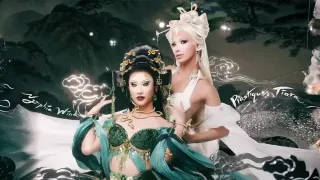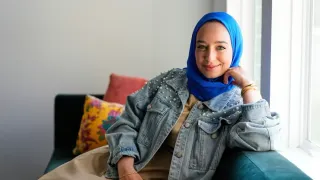July 29, 2014
Back to the 80s: Patrick Kelly's Legacy Celebrated in Philly Show
David Perry READ TIME: 8 MIN.
"I think of myself as a black male Lucille Ball, I want my clothes to make you smile," Patrick Kelly once proclaimed, and he injected an instantly recognizable sense of humor into his work, from the oversized buttons that became his trademark, to the candy colors of his clothes, to the size 56 overalls he always wore.
A brilliant force on the catwalks of the 1980s, and whose fashions graced the figures of Bette Davis, Princess Diana, and Vanessa Williams, Kelly shot to fame in 1985, only to have his life, and brand, cut short by the AIDS virus in 1990. In 1988, shortly after receiving financial backing from the fashion powerhouse Warnaco, Kelly became the first American and the first black designer to ever be elected into the elite Chambre Syndicale du Pr�t-�-Porter. But in an industry where the looks change every six months, a five-year tenure - even a bright one - quickly vanishes from world consciousness. Now, thanks to a donation of Kelly's work by his life-partner Bjorn Guil Amelan, the prestigious Philadelphia Museum of Art will be exhibiting a retrospective of the designer fashion editors gleefully heralded as the "New King of Cling."
"What Kelly achieved during the 1980s has continuing resonance today," says Dilys Blum, the Museum's Jack M. and Annette Y. Friedland Senior Curator of Costume and Textiles and organizer of the exhibition, entitled Patrick Kelly: Runway of Love.
"Kelly was always positive," she tells EDGE. "His branding and self-marketing were unique at the time, but now, in an age of fast fashion and brand-driven sales, it is a perfect time to reexamine Kelly's contribution to fashion history."
A Southern Boy Done Good
Born in 1954 in Vicksburg, MS, Kelly would tap much of his Southern childhood in the designs he created as an adult. Raised by his mother, a home economics teacher, and his grandmother, Ethel Rainey, it would be Rainey that first exposed the Kelly, then six years old, to fashion through the magazines she brought home. When he asked why there were no black models, Rainey, whom he would later call "chicest woman alive," replied with "nobody had time for black women." That set the young Kelly to make the time.
By high school, he was designing (although not knowing then how to sew, he had his friends make the actual pieces). After studied black history and art history for two years at Jackson State University, Kelly moved to Atlanta and began making and selling vintage clothing, and worked as a go-fer at the Atlanta Apparel Mart. He even designed for beauty pageants, such as the Miss Jackson State of Mississippi Pageant.
Ticket to Paris
Blum recounts how, after moving to New York to attend the famed Parson's School of Design, Kelly proved to be what professors evasively call an "indifferent student-swept up by the Club Kid culture, he spent more time at Paradise Garage where he made clothes for his friends to wear for clubbing. But it was through New York's riotous 80's nightlife and a chance meeting with supermodel Pat Cleveland that the web of coincidental events that brought Kelly to the height of fame began.
"Cleveland gave him a ticket to Paris," Blum explains, saying how once in the French capital, Kelly quickly enmeshed himself in the party scene, particular at Le Palace, the Studio 54 of France. Continues Blum: "He was designing costumes there, and doing things for friends, model friends, and probably at that point selling some of his designs anonymously to the Sentier a clothing manufacturers in Paris."
Fast fashion designs
After stints in Turin and Milan, Kelly returned to Paris, selling his clothes on the street with fabric he bought on the cheap at street fairs.
"It was very 'fast-fashion' designs," notes Blum, "just something cut out for the neck, the arms and then the seam at the shoulders. He marketed his wares by having his model friends wear them on the streets with him, and that's how he was discovered by Nicole Crassat, the editor of French Elle Magazine."
It was the equivalent of Lana Turner at the soda fountain. Recognizing Kelly's genius, Crassat gave the young designer a 6-page spread in 1985, and it launched his career. Introduced in 1987 to Linda Wachner, the chief executive officer of Warnaco by Gloria Steinem (yes, that Gloria Steinem), Kelly became an international brand, and soon after signed two licensing deals with Vogue Patterns and Streamline Industries for his famous big buttons (as a child, Kelly would often lose his buttons, which his grandmother replaced with those of many different colors, a motif Kelly later adapted). He went from living hand to mouth on the Paris streets to making more than seven million dollars a year.
"The French function according to love at first sight," explained haute couture designer Christian Lacroix to People in 1987. "If they fall in love with you, they accept you. And Patrick is very lovable. Everybody loves him."
A sore thumb stands out
All fashion houses face oblivion when the creator dies; when spree killer Andrew Cunanan murdered Gianni Versace in 1997, the label was written off as done until sister Donatella took the reins. Blum and several others in the fashion industry believe that had Kelly more than five years, his brand and label could have continued even after his death. But his quick passing and the enormous fashion change when the big-hair exuberance 80s fell to the heroin-chic grunge of the 90s all but erased Kelly.
Organized into six sections, and including music and video, the Philadelphia exhibition opens with "Runway of Love," highlighting the designer's heart-shaped embellishments to his clothing, often composed from his signature buttons, and runs through to "Two Loves," Kelly's final Fall/Winter 1989-90 collection. Paying homage to cultural icons from both the United States and France, it includes allusions to the Eiffel Tower, cartoon character Jessica Rabbit, and one of Kelly's greatest muses, Josephine Baker (the exhibit includes Kelly's take on Baker's immortal Banana Dress). Along the way, visitors will see the designer coming into his own, and drawing more and more on his African-American Southern upbringing for his work and brand, such as his "Aunt Jemima" dresses and his taking a golliwog as his logo.
"My grandmother used to say to me all the time a sore thumb stands out," Kelly once said. "If you start to be like everybody else, no one pays attention to you."
A very private man
According to Blum, it is difficult to say if Kelly was out. Growing up in the South in the 50s and 60s would have acted as a break, and while his orientation was certainly known within the fashion industry, its insularity may have prevented the greater public - then under the dual burdens of Reagan's conservative America and the AIDS epidemic - from knowing. Kelly himself was notoriously evasive about his private life, going so far as to never discussing his age.
"A lot of the issues Kelly was dealing with are still problems today," Blum notes. "The lack of diversity on the runway, the difficulty of African-American designers have in making it in the fashion business."
Despite this, Kelly was ubiquitous across Glamour, Vogue, Mademoiselle and the fashion universe of the 1980's, whose pastels, fluorescents, and zebra stripes ruled the day. Fashion editors at the time relished mixing and matching outfits from different designers, and that Kelly's work could be paired with entirely unrelated designers and lines shows the classicism of his work. While his clothes were described by Time as "fitted, funny, and a little goofy," and much of his fashions seem haute couture by today's standards, Kelly made most of his work as ready-to-wear.
"Kelly is his autobiography as a starting point for his designs," Blum says "His childhood in Mississippi, his sexual orientation - they all become integrated into what he designed to be as a brand. He was very savvy about giving the same message out all the time. The photographs don't do him justice. To see his work now, from head to toe, it is very different effect. With the music and the videos and the fashion, it's a very immersing experience.
"And," she adds, "I am hoping this will set him back in the history of fashion where he belongs."
Patrick Kelly: Runway of Love continues through December 7, 2014 at the Philadelphia Museum of Art, 2600 Benjamin Franklin Parkway, Philadelphia, PA. For more information visit the Philadelphia Museum of Art website.






